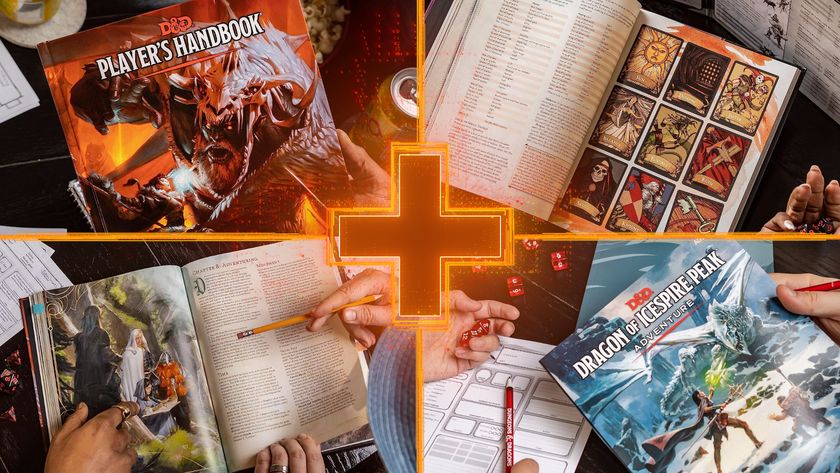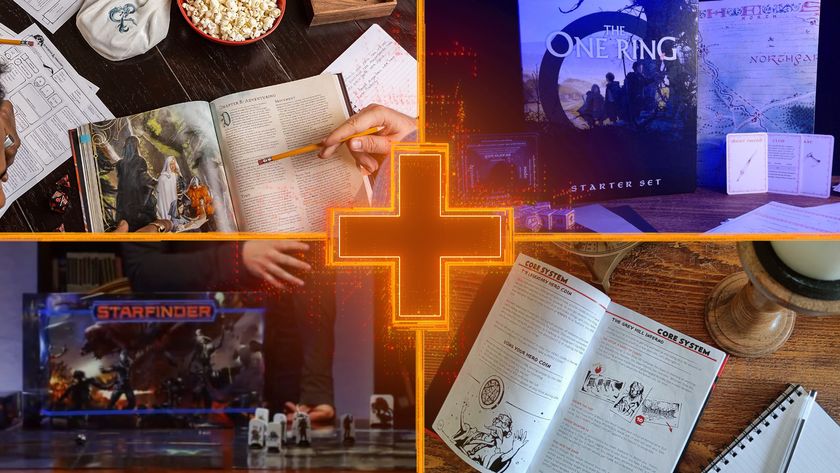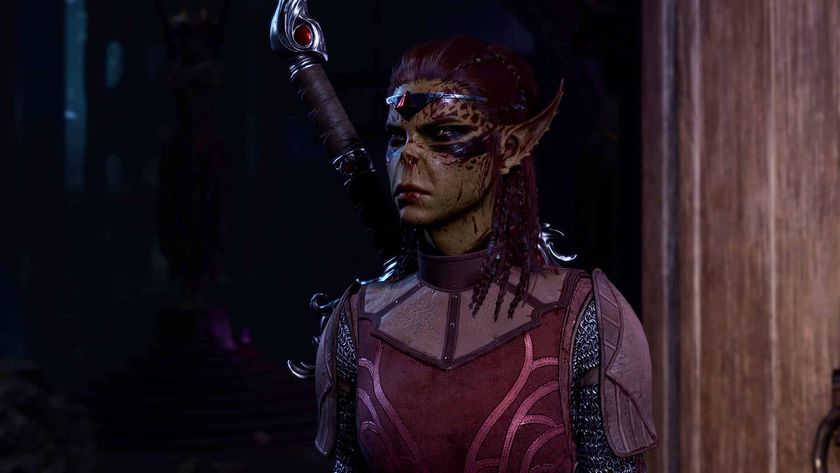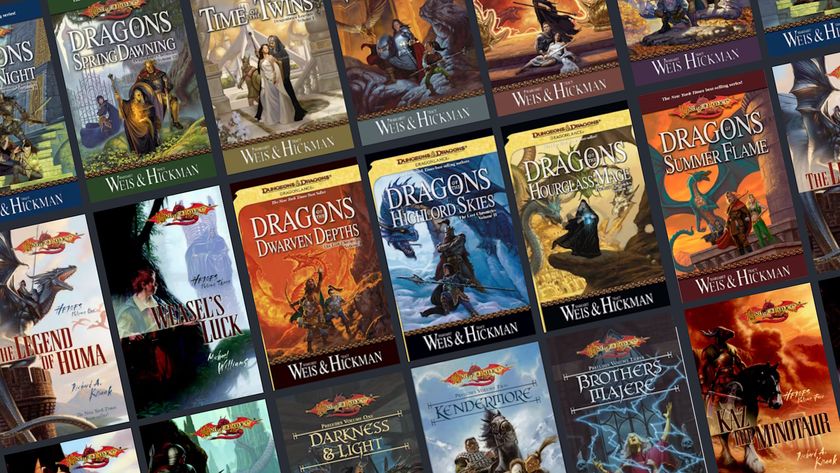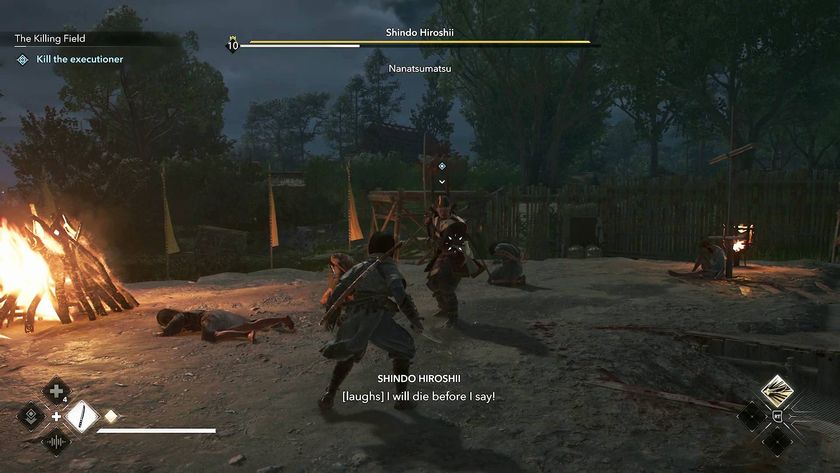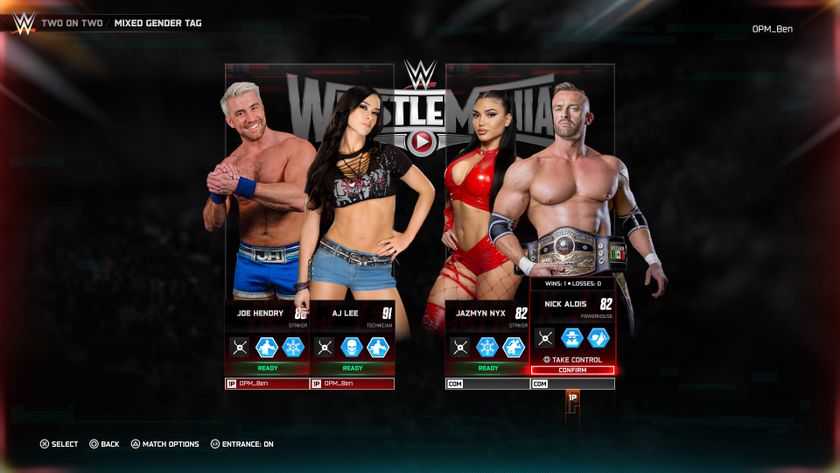How to create your first character in D&D
Don't be afraid, it's character building - here's how to create your first character in D&D

Learning how to make your first character in D&D might seem overly complex at first, but it becomes a simple process with some practice. In fact, it's the biggest hurdle you’ll have when it comes to playing the actual game.
And seriously, we can't recommend doing so enough. Dungeons and Dragons books have shot up in popularity recently thanks to the additional publicity this long-running tabletop game has had in the media, such as its mentions throughout Stranger Things and in livestreamed campaigns such as Critical Role. This means that the iconic RPG is now even more accessible than ever, with free online resources that can help you jump into playing your first session without having to spend any money on things like the Dungeons and Dragons Starter Set or Player's Handbook.
So, where should you start? The fifth edition of D&D is the most recently released version, so this is the one we'll run through the character creation process for (keep in mind that the steps in this guide may vary if you want to play older editions). And, given that this is 2022, you have the option of creating your first character either traditionally with a printed sheet and a pencil, or digitally via services like DnD Beyond. Whichever you pick, the method to ‘rolling’ your first character will be largely the same. Just remember to have a quick chat with your Dungeon Master first as some rules can vary depending on who's running the campaign.
Oh, and one more thing. If you find creating your own character to be too complex, or you simply want to get stuck in, D&D publisher Wizards of the Coast has created a selection of pre-made characters for you to download on the same page as the official blank character sheets.
Create your first D&D character - step one
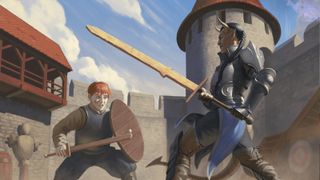
If you’re happy to create a character from scratch, you have some reading to do before you fill out your sheet. There are two things to swot up on first: class and race.
Your class (which we cover in our guide to the best D&D class for beginners) is essentially your profession, and it'll outline the kind of role you’ll have within the party as a result. Meanwhile, your race will determine how your character looks, as well as giving you exclusive skills and features such as ability score increases, age and life expectancy changes, size differences, increased speeds, and unique languages.
Choose your race
There are nine different races and twelve different classes to choose from in the base game's Player's Handbook, but additional offerings are included throughout various expansions such as Tasha’s Cauldron of Everything and Volo's Guide to Monsters. In terms of species, these range from traditional elves and halflings to more exotic choices like the raven-esque kenku.

There are seven different dice used in D&D, with the most common being a D6 (a six-sided dice) and a D20 (a 20-sided dice). You’ll also have a D4, D8, D10, D12, and a D100 to play with, but there's no need to panic if you don’t have physical ones to hand. You can use Wizard's official digital dice roller, or if you’re on DND Beyond, then the service has a digital dice roller built into the website.
Even though a lot will hinge on what you like the look of, be aware that your choice can have an impact on gameplay too - it’s possible to pick race and class options that are optimized to work together. For example, a Wizard uses the Intelligence ability to cast spells, while gnomes get to add two extra points to their Intelligence modifier, making them well suited for each other. However, you’re truly free to create whatever combination you like. Want a gnome Fighter? Go for it.
It's also worth noting that Tasha's Cauldron introduces rules that allow you to put ability bonuses wherever you like; instead of having to stick with an elf's increased dexterity or an orc's boosted strength, you could change their stats entirely. With that in mind, you could run with an academic orc professor or a surly elven barbarian who just wants to smack stuff with their axe. In short, don't feel beholden to the increases listed in the Player's Handbook - there are alternatives.
In the meantime, we've laid out races and how they work in D&D's basic rules below.
- Humans: You'll probably be familiar with these all-rounders. They're pretty good at everything, so their ability scores in the basic rules are increased by one point each.
- Elves: Long-lived and ethereal, elven adventurers in the basic rules are known for greater dexterity that helps them excel as archers or warriors relying on finesse.
- Dwarves: If you want a hardy character that holds fast in the thick of battle, consider dwarves - those from the core rules have an improved Constitution score.
- Halflings: Hobbits by another name, halflings are perfect for stealth classes thanks to being very dextrous in the basic rules.
- Gnomes: As D&D's tinkerers, gnomes excel at anything requiring brain-power according to the Player's Handbook - they have increased Intelligence points.
- Dragonborn: These characters do what they say on the tin - they feature their namesake's superior Strength to go with higher Charisma in the core rules.
- Half-elf: Because they mix the best of humanity and elven-kind, half-elves benefit from a high Charisma score and two other increases of your choice in the basic rules.
- Half-orc: Looking for a battle-ready tank? Half-orcs get a boosted Strength score and are generally hardier than other races in the basic rules.
- Tiefling: The result of demonic ancestry, tieflings boast greatly increased charisma and an improved Intelligence score if you're going by the Player's Handbook.
There's no need to limit yourself to the species above, of course - they're just the easiest to get hold of by virtue of being free. If you're willing to invest, you can choose from over 40 different races.
Decide your class
When it comes to classes, you can pick between combat-heavy martial options, spellcasters, or a mix of the two. We've listed the core options below (you can also choose to be an Artificer, but that requires the separate purchase of Tasha's Cauldron of Everything).
- Fighter: This class is exactly what it sounds like - the muscle of the group. They're a dab hand with all kinds of weapons and armor.
- Barbarian: Want to hit things as hard as possible? Barbarians can take advantage of 'Rage' mechanics that send them into a deadly fury.
- Warlock: If you want the easiest spellcaster class, try the Warlock. They're still powerful mages, but have fewer choices to tangle them up.
- Paladin: Holy warriors that draw power from their gods, Paladins blend martial combat and magic together.
- Ranger: Excelling at combat from a distance, this class stands out because it also comes with an animal companion.
- Monk: Hand-to-hand experts, monks are powered by a mystical force called 'ki' and are a good introduction to D&D's resource management mechanics.
- Rogue: The classic thieves, sneaks, and assassins of D&D are a great place to start if you want someone with an underhand skill-set.
- Cleric: Much like the Paladin, Clerics are holy warriors that are often seen as the 'healers' of the party - they have access to many useful spells.
- Sorcerer: Powered by a magical birthright, Sorcerers are an excellent choice if you want to dabble in magic - but they require a lot of forward planning.
- Bard: Toss a coin to your... er, Bard. These singers, actors, and performers boost their party from the sidelines.
- Druid: Masters of nature, Druids have control of the natural world and can even transform themselves into a beast.
- Wizard: While they're the most complicated class, Wizards are arguably the most iconic as well - they have access to devastating magic.
Because different roles within the party come with their own learning curves, it might be worth selecting a D&D class that's good for new players (again, check out our beginner D&D class guide for more). A Fighter or Barbarian is a great place to start.
While it may look scary thanks to a wealth of boxes and modifiers, it's pretty straightforward
No matter what you choose, always roll your first character from level 1 where possible to give yourself time to learn skills as you level up, rather than jumping straight into a higher level and getting overwhelmed right away.
Settle on a background
Your background can also be selected from a predetermined list to give you additional skills. There are thirteen in the Players Handbook, with more options available through other official sourcebooks and homebrew alternatives (ideas created by players). These not only help to flesh out the personality of your character but provide some useful skills that you would have picked up along the way - such as soldiers gaining proficiencies in Athletics and Intimidation.
Create your first D&D character - step two
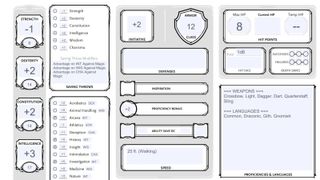
At its core, Dungeons and Dragons is a game of maths and chance. Don’t let that intimidate you though, as the most you’ll be doing is adding or subtracting from the results of a dice roll.
A good example of this would be your character sheet. While it may look scary thanks to a wealth of boxes and modifiers, it's pretty straightforward to fill out. To start with, you'll need to create six core abilities: Strength, Wisdom, Charisma, Dexterity, Intelligence, and Constitution. These Ability scores, or stats, are what determine your character's strengths and weaknesses.
The most common methods to decide those values are:
- Standard array, where you'll put pre-selected scores (15, 14, 13, 12, 10, 8) into Abilities of your choice
- Roll three D6s six times and use these six totals for your ability scores
- Roll four D6s six times, subtract the lowest number rolled each time, and use those totals
- Roll a D20 six times and use these scores (this is a more hardcore method, given the chance of having to use a low number)
- Point buy, where you have a set amount of points to distribute across your stats as you see fit
If you’ve done all that, you should have six numbers between 1-20 to allocate into your character sheet.
You’re free to roll your Ability scores first and create a character that will best suit the results
While it’s best to know at this stage what class and race you want to play so you can put scores where they'd be of most use, you can vary the order of the steps outlined above. Similarly, you’re free to roll your Ability scores first and create a character that will best suit the results.
For example, if I wanted to create a Wizard, I should put my highest number into Intelligence as that will be the most used ability score for casting spells, the main action a Wizard will take. Similarly, I may want to pick a race that can increase that rolled score (such as the +2 that gnomes get). From here, I can work out what my ‘modifiers’ will be.
Understand your modifiers
Modifiers are what you’ll be adding or subtracting from your D20 rolls to dictate how well you perform a certain action. Running with the same example, if your Wizard character has an Intelligence score of 14, then they have a +2 modifier to add.
Basically, modifiers work in 2s; a score of 12 or 13 is +1, a score of 14 or 15 is +2, and so on. Unfortunately, this also means that scores of less than 10, such as a Strength score of 8, will give you a modifier of -1.
This means if the DM asks you to roll a D20 against a certain skill, you can add or subtract these modifiers from your results. The higher the modifier, the more likely you are to succeed in your chosen action.
Create your first D&D character - step three
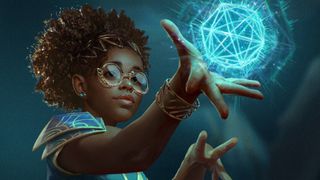
You’ll likely notice there’s still a lot to fill in, but you’re on the home stretch now and things get easier from here. On the long line of ‘Skills’ that lists things like History (INT), the last three letters refer back to the main six stats you’ve already rolled. For most of these, you can simply add your existing modifiers to each skill. For example, if you have 14 Intelligence, then you have a +2, so all the skills that use Intelligence will also have a +2.
The only exception is is if you have proficiency with that skill. Proficiencies are dictated by your character's background and class and basically mean that they're especially skilled in certain areas, so take care to read all the information available when building your character. The bonus starts at +2 for a level 1 character and caps out at +6, so if our example Wizard has proficiency in Arcana, they will have the +2 from their Intelligence and an additional +2 from their proficiency bonus. If the Dungeon Master asks the Wizard to roll an Arcana check, they can now add +4 to the result of their D20 roll.
Figuring out bonuses
Saving throws that help you avoid danger are worked out in much the same way. For regular saving throws, you just need to add your established ability modifiers (so a +2 Intelligence will result in a +2 to any saving throw using Intelligence).
Because your class will dictate which saving throws you’ll be proficient in, you should have two saving throws where you’ll also add your proficiency bonus. In the case of our Gnome Wizard, this is Intelligence and Wisdom.
A higher bonus could result in you being first in line to lay some pain down on an enemy
As for Initiative (which decides when you act in combat), you can work out if you have any bonus to your score by using your Dexterity modifier. It's worth checking to make sure that your class and race don’t add any additional bonuses, too. That's because a higher bonus could result in you being first in line to lay some pain down on an enemy.
Decide your Hit Points and Armor Class
Hit points are our next blank to fill in. Every class has a different ‘Hit Dice’ that varies from a D4 up to a D12. From first level, you’ll take the highest possible score and add the bonus from your constitution modifier - again, using our Wizard as an example, this means their D4 automatically gives us a 4 + 2 from Constitution, making for a total of 6 hit points. When working out additional hit points per level, you’ll either roll the dice assigned to your class and add the result, plus your Constitution modifier again, to the total, or take the fixed average mentioned in the class description.
Next, you’ll want to work out your Armor Class. The easiest way to do this is to remember that when unarmored, your character’s AC is 10 + their dexterity modifier. This also introduces equipment, as your AC will change if your character can wear armor or carry a shield - remember to check what armor types your character can wear in its class details, and discuss items like shields with your DM. In the case of our Wizard, this means their AC is 12 because they’re unable to wear any armor that would give them an additional boost.
There’s plenty more to go through, such as equipment and spells that will be specific to your character's race and class, but if you’ve followed all the above steps, then you’ll have yourself a playable character that’s ready to join a campaign.
Final notes
It’s worth doing plenty of research before jumping into your first session, though most inexperienced players find they can create a character sheet in around 20-30 minutes. Ideally, ask your DM or a more experienced player to help you to avoid any confusion, but if you’re an entire group of people who have yet to experience playing D&D before, just make sure you consult the Player's Handbook and Dungeon Masters Guide - they really do have the answer to almost any question you have.
To see what else is out there, don't miss the best tabletop RPGs. It's also worth checking in on the best WizKids miniatures for beginners if you want to represent your character on the tabletop with models. Want something a bit different for game night, on the other hand? Check out the best board games.
Sign up to the 12DOVE Newsletter
Weekly digests, tales from the communities you love, and more

Jess is TechRadar's Computing writer, where she covers all aspects of Mac and PC hardware, including PC gaming and peripherals. She has been interviewed as an industry expert for the BBC, and while her educational background was in prosthetics and model-making, her true love is in tech and she has built numerous desktop computers over the last 10 years for gaming and content creation. She can often be found playing games of both the Video and Tabletop variety, occasionally streaming to the disappointment of everyone. A conversation of any length will likely result in her trying to convince you to start playing D&D, though she'd settle for an evening of painting miniatures at a push.
- Benjamin AbbottTabletop & Merch Editor
